Visiting Uxmal - Everything you need to know!
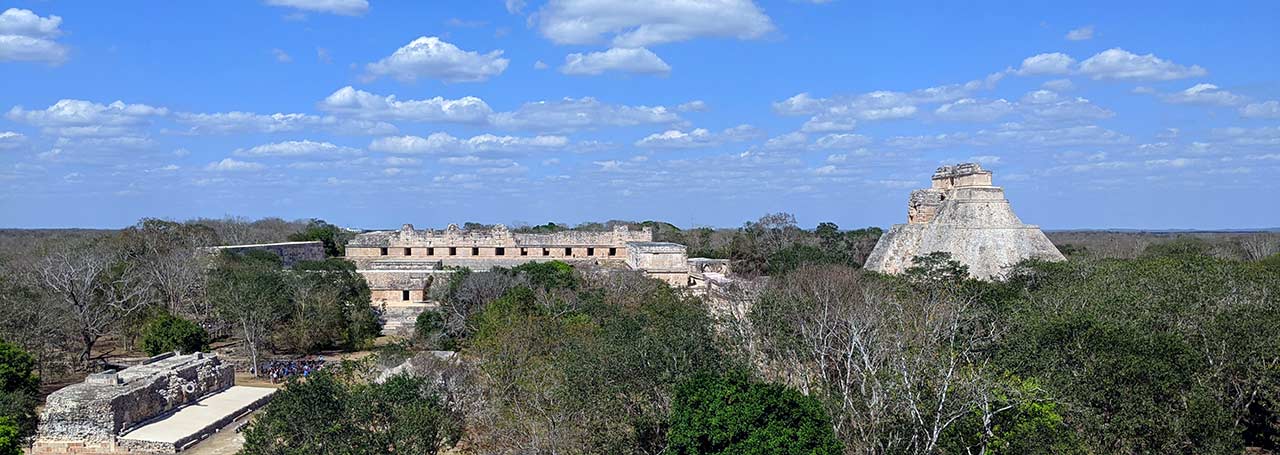
Is visiting Uxmal worth it? Yes! In our opinion, visiting Uxmal Mayan Ruins is a better option that visiting Chichen Itza,
They both have merits. Chichen Itza is an amazing and impressive Mayan ruin. But Uxmal is far less crowded and cheaper. You won’t be assailed by hordes of traders offering cheap souvenirs (although you can still some at the ‘proper’ shops). Food and drink are easier to get. And there are unique features that make visiting Uxmal a ‘must see’ archaeological Mayan site.
Overall, Uxmal is a nicer day out.
However, if you’re staying in a hotel along the Riviera Maya, Chichen Itza may make more sense due to the distance. But if you’re in Campeche, Valladolid or Merida – don’t miss out! Uxmal should be on your list of day trips.
A day trip to Uxmal from Merida is the ideal way to enjoy this amazing Mayan ruin. If you’re unsure how to get to Uxmal, I’ve given several options below, along with the benefits.
This article covers all the information you need to get the best from your trip to Uxmal.
How to get to Uxmal
When visiting Uxmal, the best place to start is Merida. A day trip to Uxmal from Merida is great because the journey is only about 70 minutes, along reasonably good roads. The best three ways to use when visiting Uxmal from Merida are:
- Car
- Bus
- Coach
A taxi is possible but is likely to be very expensive when compared to the other options.
The Mayan Train will stop at Merida, which is the best place to disembark for Uxmal – but the train journey itself is expensive and not really faster than by car for the Riviera Maya. There is no Mayan Train from Merida to Uxmal.
Personally, I would only bother to use the Mayan Train if you’re planning on visiting Merida from Cancun as part of a longer trip.
Visiting Uxmal by car
If you’re no sure how to get from Merida to Uxmal, you can use your GPD (Waze or Google maps). It’s an easy drive, without tolls, along the 261 Highway.
If you’re coming from Merida by car, the archaeological site of Uxmal is just before the bend but it’s well signposted.
When you turn off the main road, you’ll drive past a few buildings to get to the car parks. One is a dirt road and the other is on the grounds, which is the best to aim for. As with many things in Mexico these days, the prices go up with little warning. On our last visit, the car park cost MXN80, which is reasonable.
Visiting Uxmal by coach on a tour
If you’re staying in most of the larger hotels in Merida, they will have details of tours from Merida to Uxmal. The prices vary, as you would expect. The prices start at around MXN1,000 per person but can quickly go above MXN2,000 if you add other destinations in.
You can try this link to get an idea of the costs before contacting a local tour group.
Visiting Uxmal by Bus
To me, this is the option requiring the most effort when visiting Uxmal! You need to get the bus from TAME Bus Station at Calle 69, No. 55, between Calles 68 and 70, Merida. There is no ADO bus from Merida to Uxmal, so don’t get confused and go to the wrong bus station as they are close to each other! You need the SUR bus from TAME station.
You need to get an early bus (8 am) and be sure to check the return times. These have been changing lately, so check ahead. It’s best to arrive early to get a good seat. There are a couple of stops on the way and the journey should take about 90 minutes.
The bus stop at the Uxmal archaeological site is close to the entrance of the road to the car park, so you don’t have to walk too far. The cost is about MXN100 per person each way. Whether that’s worth the hassle is up to you!
Other routes to Uxmal
The easiest place to stay when visiting Uxmal is Merida. But that may not always be practical, so here are some distances in case you want to do a day trip to Uxmal for elsewhere:
Unfortunately, Uxmal is nearly 5 hours by car or coach from Cancun to Uxmal and other Riviera Maya holiday destinations are about the same. In my opinion, that makes visiting Uxmal as a day trip impractical.
Campeche to Uxmal is about a 2-hour drive, so this is a reasonable day trip if you leave early enough.
The distance from Valladolid is 150 miles (240 km) and nearly a 3-hour drive. That’s a long way if you are doing the driving. You can get tours from Valladolid, which may be a better option if you are keen to visit Uxmal.
If the length of the journey is off-putting, consider staying overnight!
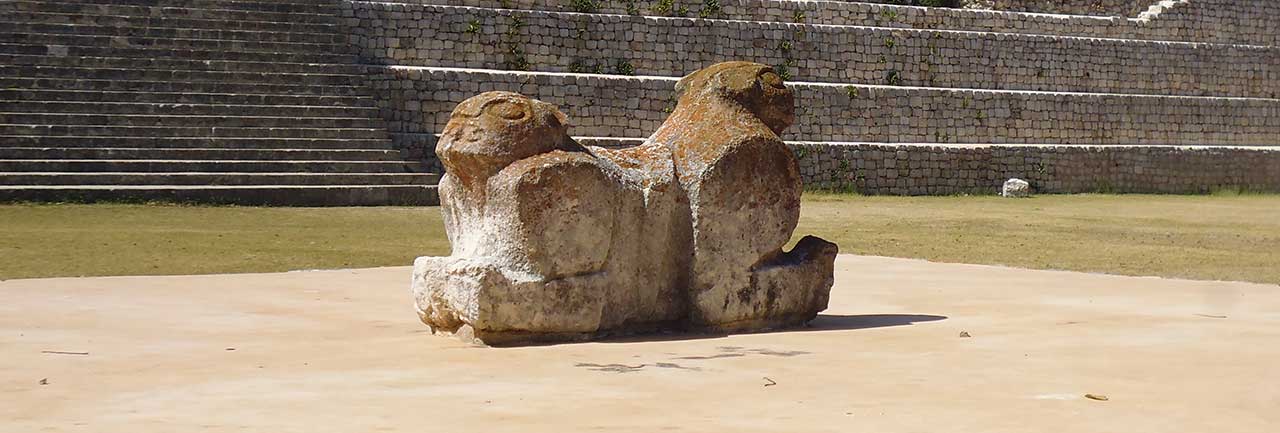
Can I stay overnight nearby when I’m visiting Uxmal
If you are wondering where to stay nearby when visiting Uxmal, there are three options, all very close. As it is only just over an hour from Merida, most people don’t bother and do a day trip from Merida to Uxmal. Unlike, Chichen Itza, Uxmal doesn’t get horribly crowded, so an early start is not as critical. The three options close to Uxmal are:Uxmal Resort Maya
Located about 1.2 miles from the Uxmal Mayan Ruins, this is a large hotel with several room types and a large swimming pool. We had a drink by the pool which was very pleasant. The staff were great but the hotel looked a little tired, but nothing serious.Hacienda Uxmal Plantation & Museum
This is a lovely hotel right across the road from the Uxmal archaeological site entrance. The original hacienda opened in 1683and it is now the oldest hacienda hotel in the world! This sort of luxury comes at a price. However, if you are only on a day trip and get a chance, it is well worth just looking around. The Uxmal Cacao and Chocolate Museum is on the grounds of the hotel.The Lodge At Uxmal
This is another luxury hotel, sister to the Hacienda Uxmal but more modern. It is closer to the Uxmal Mayan Ruins, located ‘within the Uxmal Archaeological Park’. In reality, that means in the small road leading to the entrance to the site not in the actual ruins area. Slightly further afield:The Pickled Onion Eco-Boutique B&B
About a 10-minute drive from the Uxmal archaeological site is this charming boutique B&B. Located in the small town of Saint Elena, it is run by an English lady, Valerie Pickles. It gets 9/10 reviews on Booking.com. The Pickled Onion also does packed lunches, which may be useful if you’re touring the area!How much does it cost to enter Uxmal Ruins?
The cost of entering many of the Mayan Ruins in the Yucatan has gone up recently and they continue to rise without warning. The Uxmal ruins entrance fee is no exception.
According to the official website, the Uxmal ruins entrance fees are now MXN95 (for the INAH portion) and MXN441 (for the Government of the State of Yucatán portion), so MXN 536 in total.
If you are a foreign resident or a Mexican citizen the Government fee is MXN150. (All fees are waived on Sundays for foreign residents and Mexicans.)
You pay your fees at the gate but at two separate windows. The INAH portion must be paid in cash you might be able to pay to pay the Government portion by card. This doesn’t always work so it’s better to bring cash for both.
If you’re bringing professional-looking camera equipment, there is a fee of MXN50. That doesn’t apply to ‘normal’ cameras, phones, etc.
This information is correct as of January 2024.
There is an ATM at the entrance but I would suggest you draw any cash you need in Merida in case it’s not working. It’s a good backup though.
What are the opening hours at Uxmal?
Uxmal Archaeological Zone is open 7 days a week. The opening times are from 8 am to 5 pm. The ticket counter closes at 4 pm.
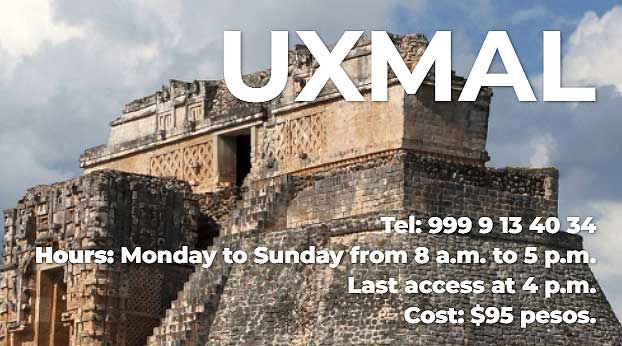
How long do I need at Uxmal?
How long you spend at Uxmal depends on your interest in Mayan architecture. Uxmal has some of the best Mayan ruins in the Yucatan and with smaller crowds than Chichen Itza, it’s a pleasure to wander around them at your own pace.
Typically, we expect our friends from overseas to spend about 2 hours at Uxmal. If you are an avid photographer, you’ll probably spend longer. Tabitha is normally still exploring nooks and crannies after 3 hours!
We’ve never hired a guide but if you did use one, you should allow around three hours.
But don’t race around the Uxmal site. There are many hidden or obscure carvings or sculptures if you look hard enough!
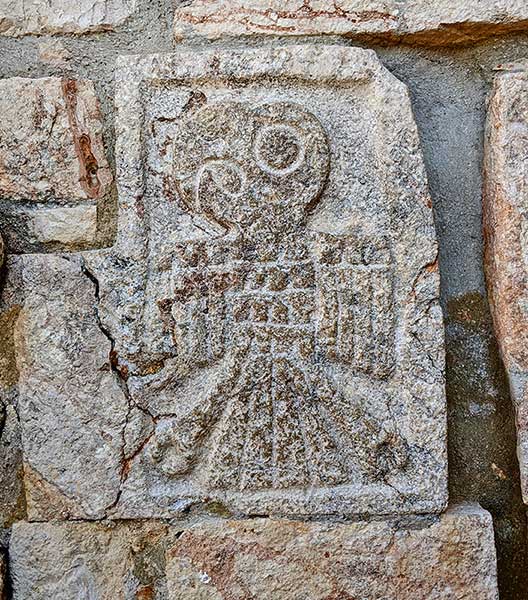
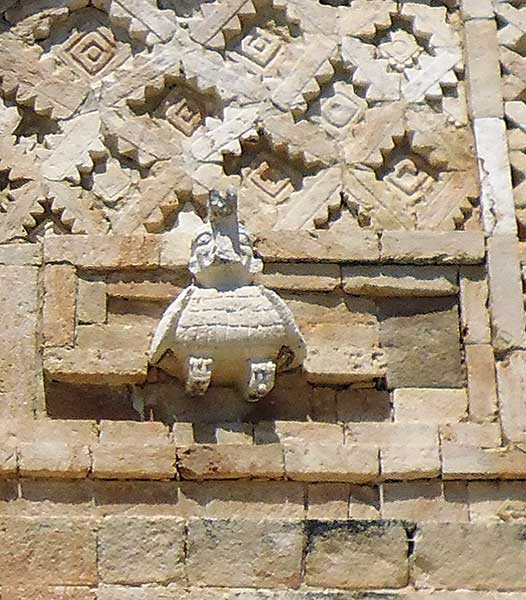
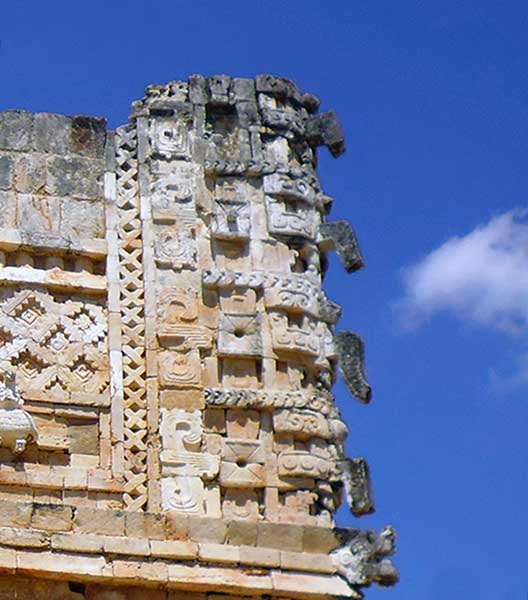
What should I bring when visiting Uxmal?
Cash
You need to bring enough cash to cover all aspects of your visit. You have to pay part (sometimes all) of the entrance fee in cash. If you use a guide at Uxmal, you will need to pay them in cash. If you’re driving to the site from Merida, cards are often not accepted in the smaller towns.
Camera or phone
It may be redundant to remind you to bring a camera or phone to take photos. There are awesome opportunities to get some of the best snaps of your holiday here. So double-check your batteries are fully charged and you have space on the SD cards.
Don’t laugh – I’ve seen some very sad faces on tourists who’ve just realized their cameras don’t work!
Mosquito Spray
I’ve never had a problem with mosquitoes at Uxmal, nor has Lesley and she is a bug magnet! Some visitors have said they had a problem but that may be at a specific time of year. The rainy season tends to bring them out and there’s a lot of jungle nearby, so you may want to take some bug spray to be on the safe side.
Sun Screen and a hat
Make no mistake, it can get very hot in the Yucatan in the summer and visiting Uxmal is no exception. Uxmal is a big archaeological site, with a fair amount of walking between buildings. That means walking in the sun. Bring a strong sunscreen and a hat.
Water
With the heat, it’s easy to get dehydrated. You can take water bottles into Uxmal and buy drink at the entrance, so take time to stay hydrated.
Good footwear
Good footwear, not flip-flops, is recommended. Uxmal covers an area of about 150 acres (60 hectares). You won’t cover a fraction of that area but you will do a lot of walking. Some of the terrain is uneven and rocky.
If you climb steps or walk across concrete areas, you risk slipping or tripping. After heavy rains, some of these surfaces become extra slippery.

What are the restrictions when visiting Uxmal?
Like many Mayan ruins in the Yucatan, you cannot climb the pyramids or most of the main structures. However, you can climb the steps of some buildings, for example the Governor’s Palace. This allows you to take photos across the Nunnery Quadrangle and toward the Pyramid of the Magician. The areas you are not allowed to climb are clearly marked.
Tripods are not allowed at the site.
You cannot use drones of any size at Uxmal or any archaeological zone in Mexico. If you try to fly, you risk confiscation of your drone and you could face a fine.
You are not allowed to eat while inside the ruins but there are food stalls by the ticket offices where you can grab a bite.
What’s the best time to visit Uxmal?
What’s the best time of year to visit?
Uxmal is in the Yucatan, so the seasons play a big part in how much you’ll enjoy your visit!
The seasons vary from year to year (like everywhere these days). But typically, April to September is hot, with April and May being the hottest, around 98f (37c). June to October normally has the heaviest rain. This often comes in heavy downpours that only last a couple of hours and mainly in the afternoon. Unfortunately, the combination of heat and the rain pushes the humidity up high.
Visiting Uxmal any time from late October through March can be better as months are cooler and drier. January and February can often be quite pleasant!
But we’re talking weather, so you can get dry days in the wet season and wet days in the dry season. A bit of rain might dampen your visit but it’s unlikely to last all day. But be prepared for the heat.
What’s the best time of day for visiting Uxmal?
If you want the site to yourself, aim to arrive just after opening time. But the crowds are nowhere near as bad as Chichen Itza and Uxmal is a bit site, so unless you turn up at the same time as a bunch of coaches, you shouldn’t feel crowded.
Morning is probably the best time to visit Uxmal both to avoid crowds and because the sun won’t be as strong or the temperatures as high as the early afternoon.
The Highlights to see at Uxmal Mayan Ruins
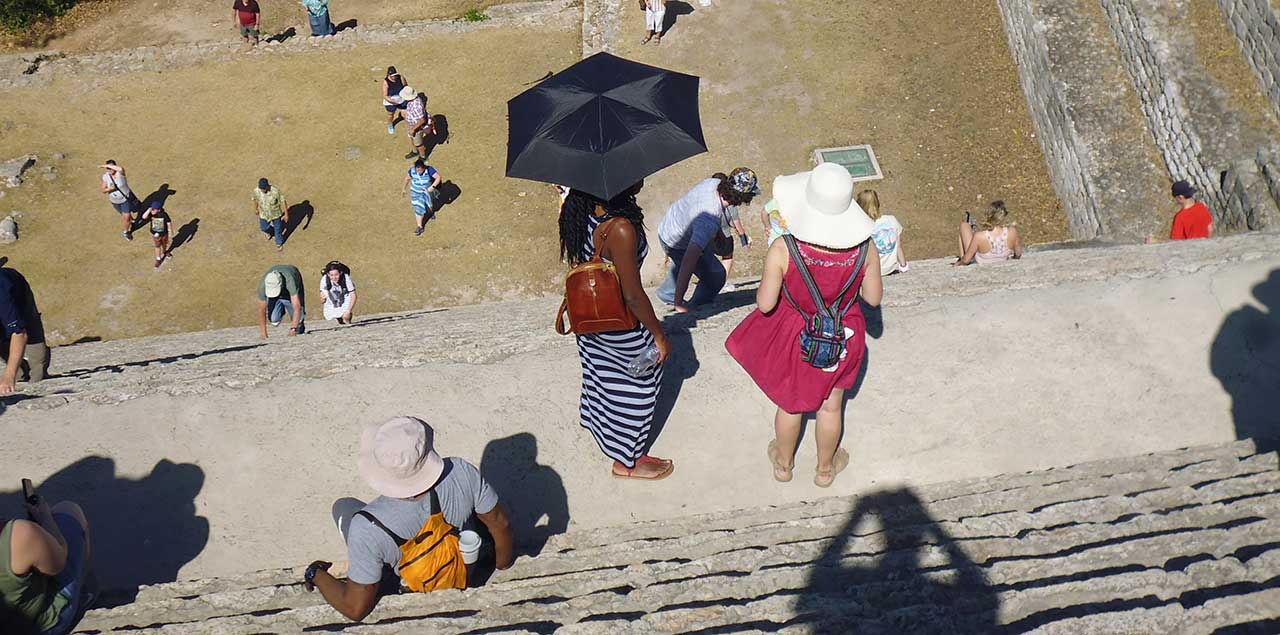
The main ruins of Uxmal cover about 150 acres (60 hectares), but the residential areas cover a much larger area. Realistically, you would need a full day and then more to study every nook and canny of this remarkable archaeological site.
Located in the Puuc area, Uxmal is the best example of Puuc architecture and building style. When visiting Uxmal, you will see some great examples as you wander around!
Puuc is a Mayan word meaning means hills. The Yucatan Peninsula is remarkably flat, so any hills are important, even the low ones in the Puuc area.
Puuc is also used to describe the Mayan architecture prevalent in this area. It differs slightly from other areas. The decorative additions to buildings are more elaborate, with Chaac (the god of rain) commonly appearing. The Puuc Mayans also used more advanced building techniques, incorporating concrete into their structures for greater stability.
Although there are some 15 buildings open to the public, the following are the main highlights for most visitors:
Pyramid of the Magician
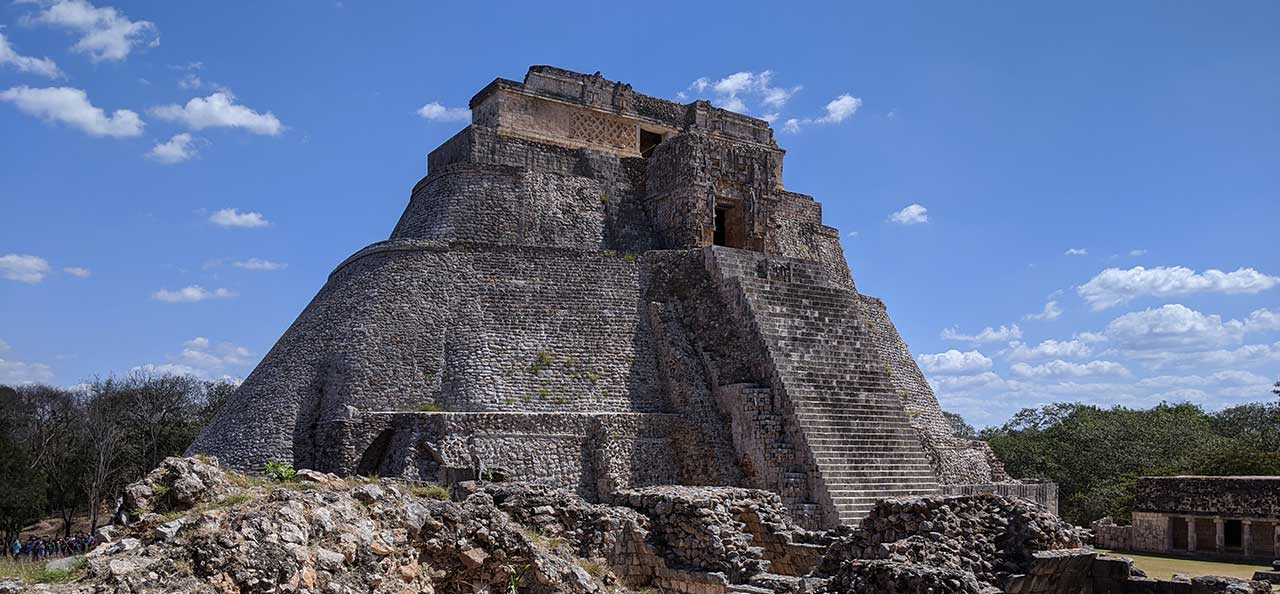
Confusingly, this pyramid has several English names, including:
- Pyramid of the Magician
- Pyramid of the Dwarf
- Pyramid of the Sooth Sayer
- Pyramid of the Fortune Teller
This is an unusual Mayan pyramid as it has a stepped structure that is oval rather than squared. It is also taller than El Castillo at Chichen Itza at 115 feet (35 meters) and has a larger base covering 227 by 162 feet (69 by 49 meters). For some reason, the exact height of this pyramid is open to debate but these are official measurements.
What you see when you look at the Pyramid of the Magician are five pyramids. Common practice was to build new buildings on top of the old to make them bigger.
Temple 1 dates from the 6th century and is the base on the west side. Hidden by Temple 2 is Temple 3. You can only enter Temple 4 from the west side. Built in the Chene style, this has the most ornate decorations. Called, among other names, the House of the Magician, Temple 5 is the top one.
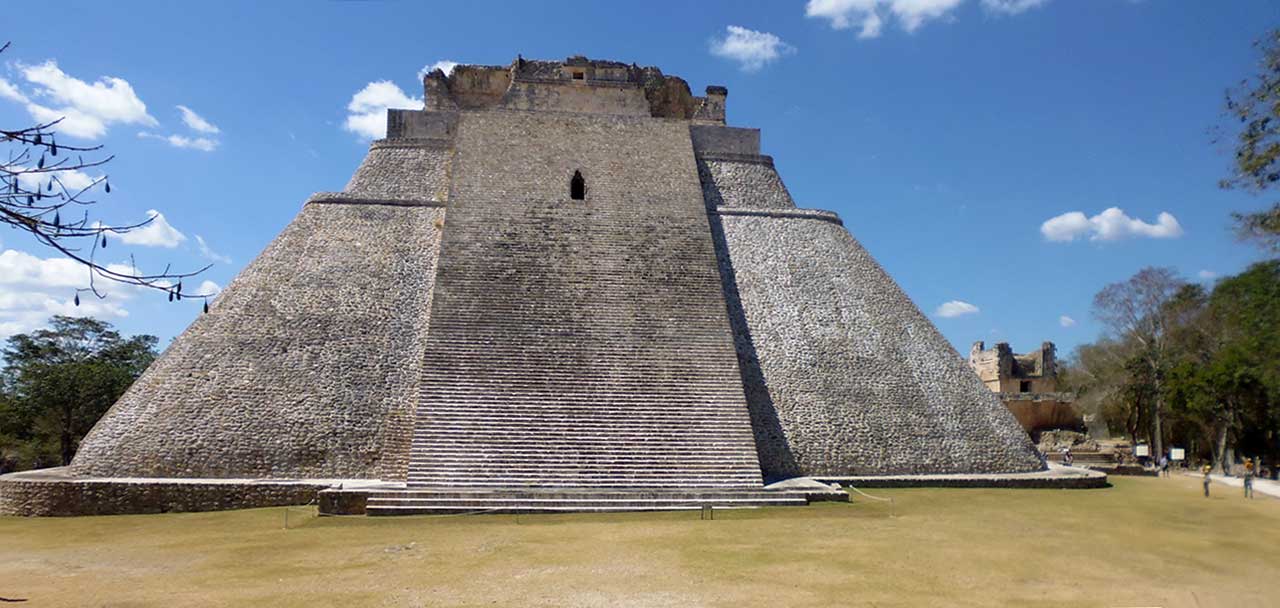
The small opening part way up the stairs was made by archaeologists to enter the pyramid and explore the other temples that are inaccessible from outside.
The Legend of the Dwarf
The name Pyramid of the Dwarf arose from a legend told to one of the earliest explorers. The legend has several versions but they have the same theme. A dwarf hatched from an egg had an issue with the ruler of Uxmal. Sentenced to death, the dwarf’s mother, a witch, encouraged the rules to spare her son if he could complete an impossible feat. The feat was the building of the pyramid in one night. The dwarf completed the pyramid during the night and everyone lived happily ever after. Except for the ruler, who was killed!
Even without legends, this is an amazing building and worth many photos (and selfies!)
Unfortunately, Hurricane Gilbert damaged the pyramid in 1988 which led to cracks in its structure. Although fixed, new ones continue to appear. Although not immediately serious, climbing the pyramid is now prohibited.
The Nunnery Quadrangle

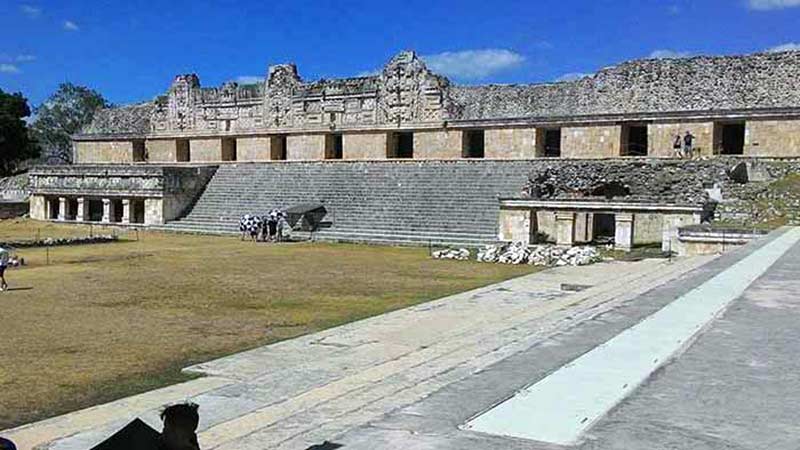
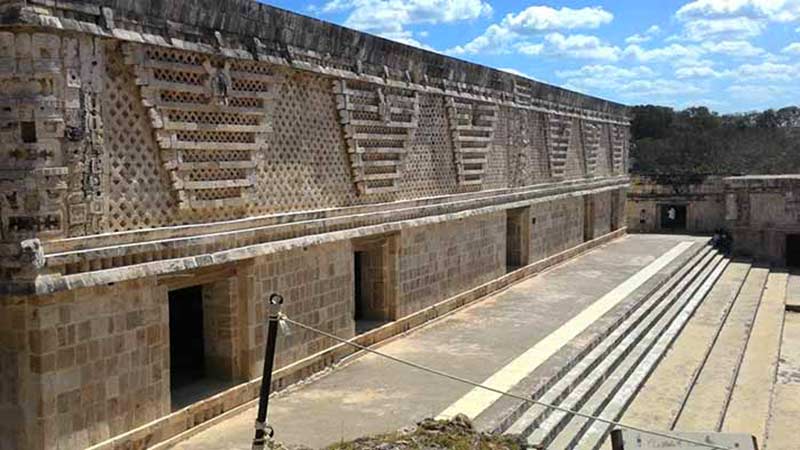
Probably built somewhere between 900 and 1000 CE, the Nunnery Quadrangle was so named as it looked like a convent to the early Western explorers. Who were obviously wrong.
It is likely these rectangular buildings are four royal palaces built around a large courtyard. There are some elaborate carvings on the walls of these four buildings that you should look out for. If you look carefully, you’ll find birds, warriors, snakes, what someone described as a fat quetzal (a bird revered by the Mayans but not fat!), and many others.
The northern building is important as it has a capstone with a longcount date of 907 CE. Longcount dates are Mayan dates we can be sure to link to our own calendars, so this gives us confidence about the completion date of the capstone.
You can spend a fair amount of time walking around the courtyard and examining the buildings and the friezes. If you’ve got a good lens on your camera, you’ll great hosts of the carvings.
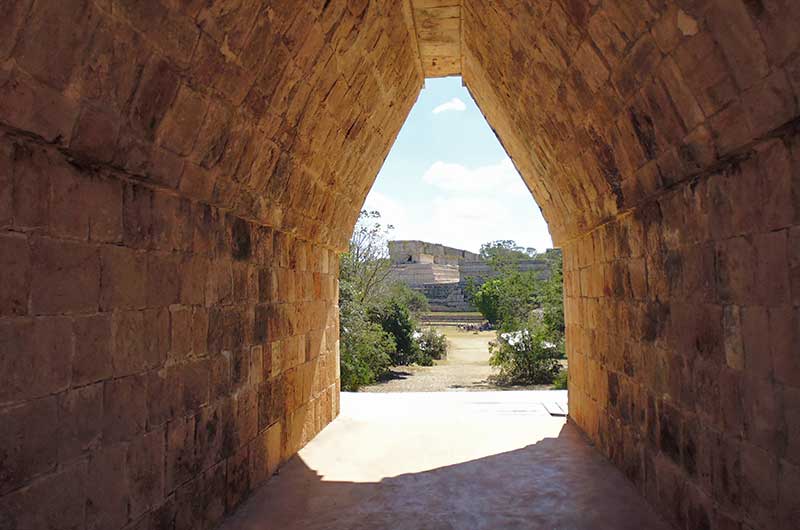
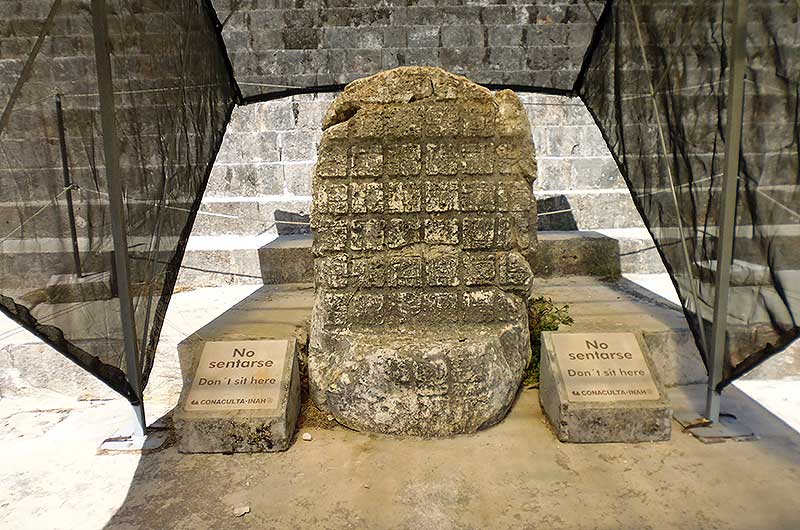
The Governor’s Palace
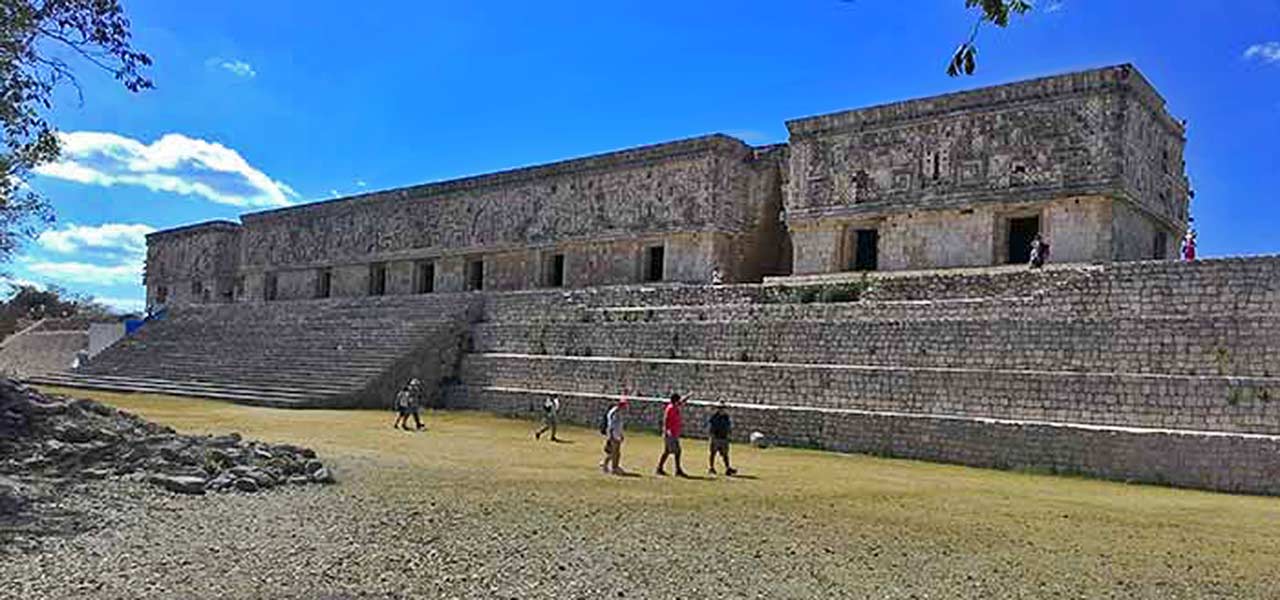
The Governor’s Palace is a long building on a huge platform. It is one of the best Mayan buildings you can visit in Mexico. It has the longest facades of any ancient site in the Americas. Early explorers raved over its design and the state of preservation.
The main building is 328 feet (98 m) long, 40 feet (12 m) wide and 27 feet (8.5 m) high. Split into three joined sections, the building stands on a huge four-tiered platform.
The assumption is that it was built later than many of the other buildings, perhaps between 1000 and 1100 CE, as it incorporates new architectural features.
It is best if you approach the Governors’ Palace from the front. That way you will see the amazing carvings and the bizarre shaped openings. The back and sides of the building have ornaments but not to the same extent.
The Governor’s palace is set at a particular angle to allow observers in the central doorway to see Venus rise over the pyramid of Cehtzuc about 3 miles (5 km) away. Current theories are that this happened to mark the start of the dry season. There are over 50 carvings of Venus symbols on these walls.
The Great Pyramid
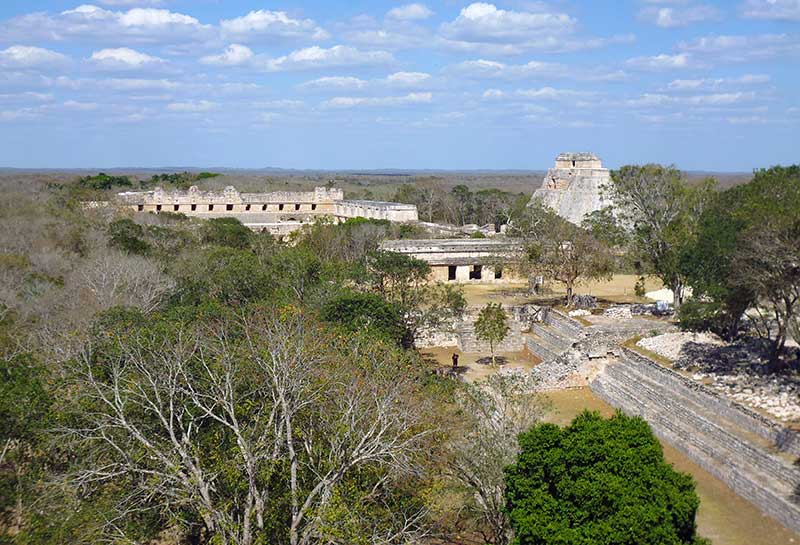
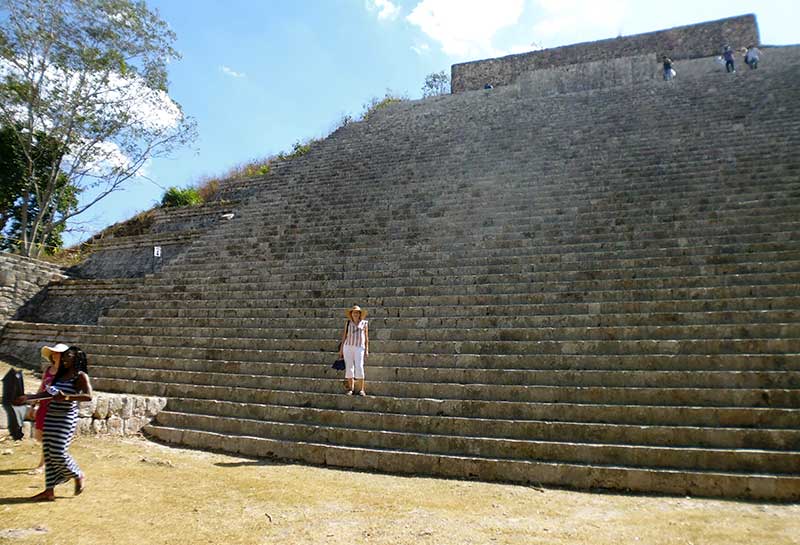
The Great Pyramid in the Uxmal archaeological site remains one of the few Mayan pyramids or even buildings you can climb these days. The stairs on the north side are steep but climbable.
The Great Pyramid is not quite as tall as the Pyramid of the Magician by a mere 15 feet (5 m) but the view from the top is amazing. You can see across the whole Uxmal archaeological site, with most of the key Mayan ruins laid out before you.
Built in the 7th or 8th Century, the Great Pyramid of Uxmal has nine segments. The top of the pyramid is the Temple of Macaws, so-called because of the sculptures of macaws on the walls.
On the pyramid you will also find sculptures of the mask of Chac, serpents, and other fantastical images from Mayan mythology.
The House of the Iguana
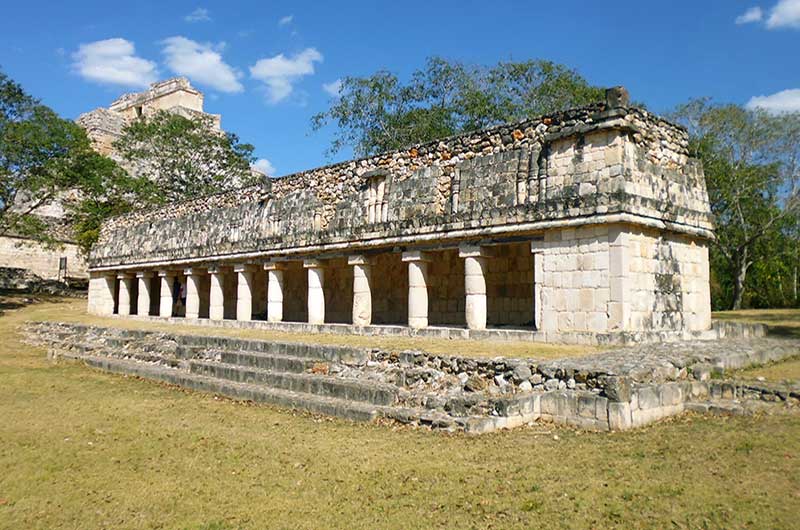
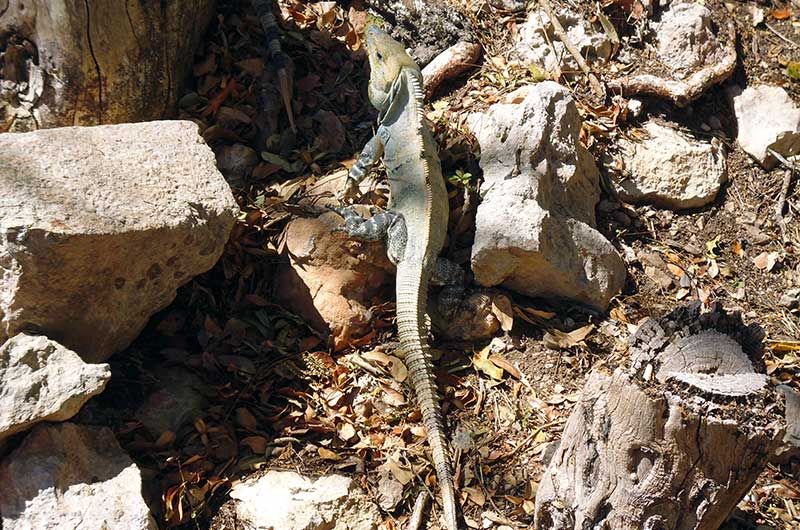
The House of the Iguana is also known as the Iguana Building, but has little to do with iguanas! The original name – and function – are unknown.
The House of the Iguana at Uxmal was probably built around the year 900 CE and incorporates a different style to many of the older buildings at Uxmal. The decorations are simpler, although still in the Puuc style. However, the 11 columns or pillars are distinctive. These may show an influence from Chichen Itza.
As it is close to the ball court, archaeologists speculate that the House of the Iguana may have links to the ball games. That may be residential for the ball players or as a storage facility for the games.
This building has nothing to with iguanas but you won’t walk far in Uxmal without seeing some. The iguanas here are Spiny-tailed Iguanas (Ctenosaura spp.) They range in size from about 18inches to four feet long. They are herbivorous, so don’t pose any threat unless provoked – and then watch out for the tail!
Iguanas love sitting on the rocks and monuments in the sun and don’t object to some iconic photos for your social media!
Other Fascinating Structures to see when visiting Uxmal:
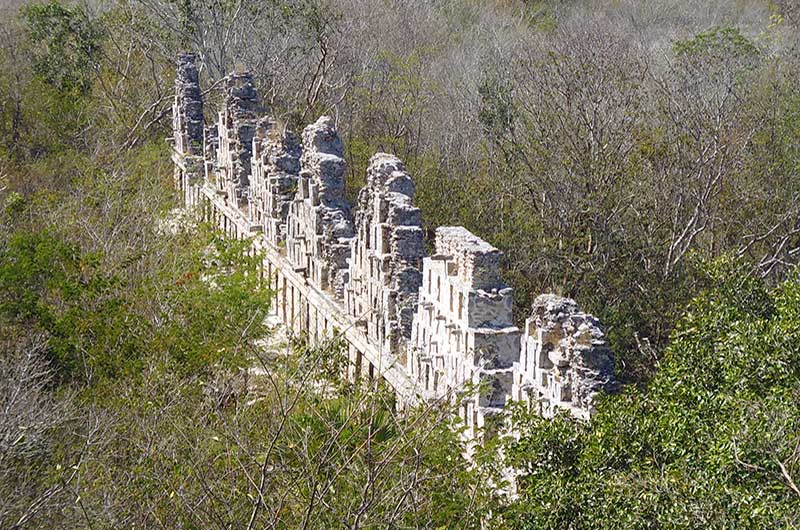
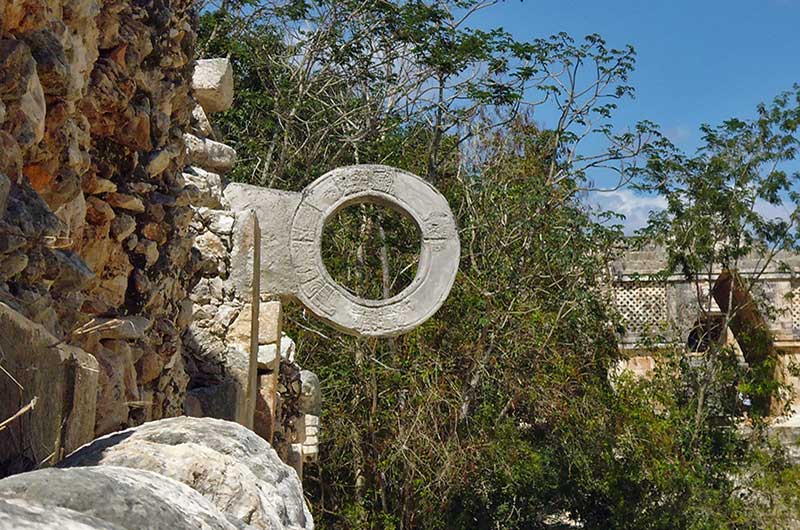
- The House of the Tortoises – which has interesting sculptures of turtles along its walls.
- Ball Court – interesting but not as well restored as, say, Chichen Itza.
- The Dovecote (or Dove House) – an amazing structure, basically a large wall with what look like (but are not) dovecotes in it. The fact that a structure like this is still standing is remarkable.
- The Courtyard of the Birds and the House of Birds – try to spot as many species of bird sculptures as you can on the walls. Do you see parrots, turkeys, quetzals, pelicans …?
Mayan History of Uxmal
There is some debate about when Uxmal was first settled. Ceramic evidence has led some to suggest a date as early as 800 BCE. This may be right for basic settlers but the buildings and monuments we see today date from the late Classic Mayan Period, probably built between 600 and 900 CE.
One thing you need to be aware of – most dates relating to the Mayan civilization are open to debate. Few dates are absolutely certain and there are gaps in our confirmed knowledge toward the end of the Classic Mayan Period. What follows is a compilation of the latest viewpoints. It is likely to change as archaeologists uncover more details.
Most Yucatan Mayan cities used a geometric pattern or compass settings when designed. However, Uxmal followed an astrological design, as seen in the layout of some of the larger buildings.
The Chac Dynasty dominates Uxmal history
The Mayan books of Chilam Balam (parts of which may date from the 16th Century or even earlier) contain stories about Hun Uitzil Chac Tutul Xiu. The stories say he established the city of Uxmal in about 500 CE. It grew from a sleepy rural town to a thriving city and was supposedly ruled over by Chac’s descendants for several generations.
The only evidence of this are glyphics found on some stellae at Uxmal. The most famous is on Uxmal stela 14, which dates from the late 890s and refers to K’ak’ Pulaj Chan Chaak or Lord Chac. Other inscriptions appear to refer to other ‘Chacs’ leading some to believe that this refers to the family dynasty.
During this time, this part of the Yucatan enjoyed more rainfall and a more fertile soil than it does today. This led to successful agriculture, which in turn contributed to the rulers’ ability to have large monuments built. At its peak, the city may have had over 25,000 inhabitants.
Uxmal and The Miyapan League
In the 9th Century, Uxmal was one of the three dominant cities in western Yucatan, along with its allies Chichen Itza and Miyapan. This alliance was sometimes known as the Miyapan League.
The League didn’t last and fighting between the cities left them vulnerable to outside attacks. At some point the Toltecs from Central Mexico invaded. Chichen Itza was apparently abandoned in the 13th Century, for reasons not fully understood.
In the same way, from the mid-1400s the population of Uxmal dwindled, possibly due to lack of rain and deforestation. Although Uxmal remained inhabited, its days as a city of influence were over.
People were still living in and around Uxmal when the Spaniards arrived in the mid-1500s but the monuments had fallen out of use.
Modern History and Restoration of Uxmal
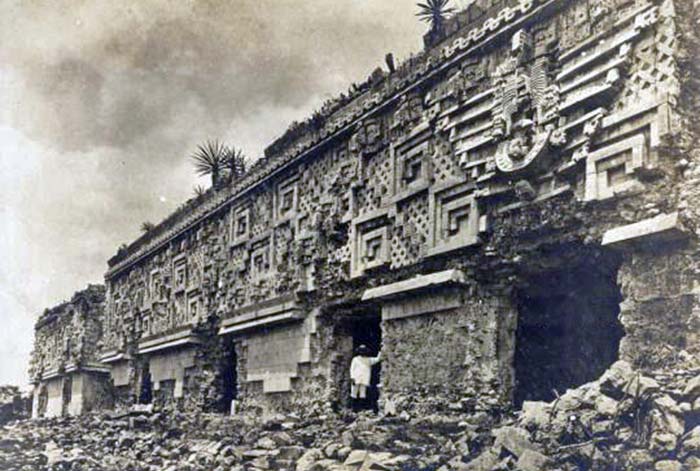
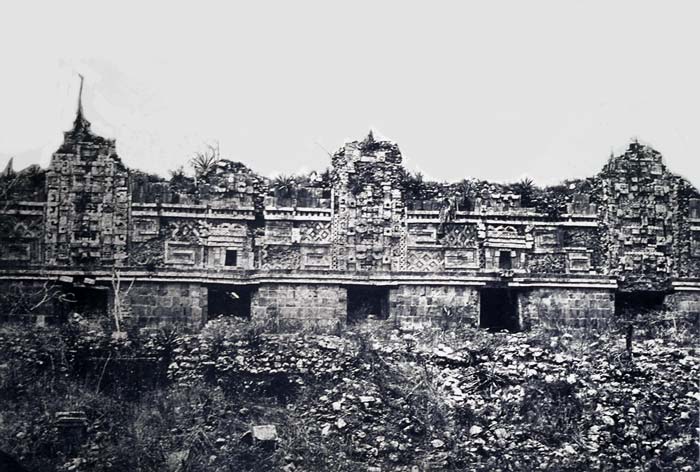
Uxmal was only partially abandoned in the mid-1400s, a hundred years before the Spanish arrived. Unlike Chichen Itza which was rediscovered, Uxmal was never lost!
The Mayans have had a keen interest in the area since pre-Spanish times. Hacienda Uxmal was built in 1683 and the owners were aware of the ruins, although it is unlikely they generated much interest then.
In 1688, Friar Diego Lopez de Cogolludo mentioned Uxmal in his book on the history of the Yucatan.
Interest in Uxmal as a Mayan ruin disappeared for about 150 years until 1834. In that year Jean-Frédéric Waldeck was hired by Lord Kingsborough to make a report and drawings on the ruins. His drawing and paintings are interesting. But they show a strong bias supporting Kingsborough’s mistaken views about the origin of Mayan architecture.
Interestingly, both de Cogolludo and Kingsborough held the view that Mayan architecture was somehow linked back to ancient Western civilization. For example, Waldeck’s drawings in his book of 1838 showing the Uxmal pyramid almost like an Egyptian one.
In the late 1830s, John Lloyd Stephens (an American diplomat) and Frederick Catherwood (an English explorer) were jointly exploring Central America studying the Mayan civilization. They soon added visiting Uxmal to their explorations. Their lithographs and drawings, along with the associated books, helped give the world a glimpse into the Mayan civilization. That ignited a huge interest in all things Mayan.
Inspired by the works of Stephens and Catherwood, Frenchman Joseph Desire Charnay visited Uxmal from 1851 to 1861. His were among the first photographs of the ruins.
The 20th Century sees the start of major restorations
Sylvanus Morley, who was also heavily involved with Chichen Itza, made a map of Uxmal in 1909, which led to the discovery of more buildings. (Morely was more than an archeologist – he used his Mayan studies as a cover for his spy activities!)
It appears that some attempts at cleaning up the site occurred in 1913 and 1914. Excavation and restoration work really started in 1923 with the help of the Mexican government. In 1928, part of the Governor’s Palace was restored after a minor collapse of the building.
In 1930, Danish archaeologist Frans Blom from Tulane University in the US led an expedition to help with the preservation of the site. They made plaster casts of various facades and monuments, which they displayed at the World Fair in 1933 in Chicago, further increasing interest in Uxmal and the Mayan world.
Continuing the work of Blom in the 1930s, Mexican José Erosa Peniche reported decay and damage of the Nunnery Quadrangle and the Temple of the Magician.
In 1935, the president of Mexico, General Lazaro Cardenas visited Uxmal. This resulted in a program aimed at rescuing monuments and buildings between 1935 and 1947 under teams led by Manuel Cirerol Sansores and José Erosa Peniche
There has been constant restoration work since then. In the 1970s INAH undertook major maintenance and repair work.
The new Sound and Light show was inaugurated in February 1975. The guest of honor was Queen Elizabeth II of the UK.
Hurricane Gilbert 1988 – why you can’t climb the Pyramid
In 1988, Hurricane Gilbert struck the Yucatan Peninsula. The hurricane caused a lot of damage to the Pyramid of the Magician. The walls and stairs showed cracks, and further investigation revealed more extensive damage.
As part of the repairs, the authorities installed movement monitors. The pyramid was successfully stabilized and disaster was averted. Unfortunately, more cracks have since occurred. This is one of the reasons that climbing the pyramid is prohibited.
FAQs about Visiting Uxmal Mayan ruins
Where are the Uxmal Mayan ruins?
Uxmal is easy to visit from Merida – it’s about 70 minutes.
It’s nearly 3 hours from Valladolid, which makes it a long day trip and even further from Riviera Maya.
The nearest Mayan Tren stop is at Merida.
How much is the entrance fee to Uxmal Mayan ruins?
According to the official website, the Uxmal ruins entrance fees are now MXN95 (for the INAH portion) and MXN441 (for the Government of the State of Yucatán portion), so MXN 536 in total.
If you are a foreign resident or a Mexican citizen the Government fee is MXN150. (All fees are waived on Sundays for foreign residents and Mexicans.)
Can I climb any of the buildings at Uxmal Mayan ruins
You can’t climb the pyramids but you can climb the stairs on some structures, such as the Governor’s Palace.
The Great Pyramid was weakened during the hurricane of 1988 and since then other cracks have been discovered.
If you find structures you can climb, treat them with respect – and enjoy climbing them while you can!
How long will a visit to Uxmal Mayan Ruins take?
That is entirely down to how interested you are in the ruins. It’s a big site, so you can easily spend 2 to 3 hours. But the Yucatan sun can make that a difficult task during the hottest months.
What is the best time to visit Uxmal?
Although the crowds are nowhere near as bad as at Chichen Itza, it’s always good to arrive as early as possible to beat the coach tours – and the worst of the hot sun!
As Sunday is free entry for Mexican citizens (and foreign residents, it’s best to avoid Sunday completely.
The best months to visit are from November to April.
What should I bring for visiting Uxmal Mayan Ruins?
Cash.
Sunscreen.
Hat.
Mosquito Repellent.
Good, strong shoes.
Camera!
Which is better Chichen Itza or Uxmal?
A lot depends on where you are staying. If you are on the Riviera Maya – Cancun, Playa del Carmen, etc., then Chichen Itza is much closer and easier to visit.
If you are near Merida, then Uxmal is the better trip.
From Valladolid, it’s still a bit far.
Personally, I prefer Uxmal. It is less crowded and, I think, more interesting. But there are many people who prefer Chichen Itza.
Is it safe to go to Uxmal?
The last part of the drive to Uxmal is sparsely inhabited compared to closer to Merida.
However, Yucatan has a good record for safety.
The roads are excellent and the people friendly.
I’ve never felt threatened or concerned when visiting Uxmal.
Obviously, like visiting any tourist attraction, keep your valuables out of sight!
Things to do near Uxmal
The Uxmal Chocolate Museum
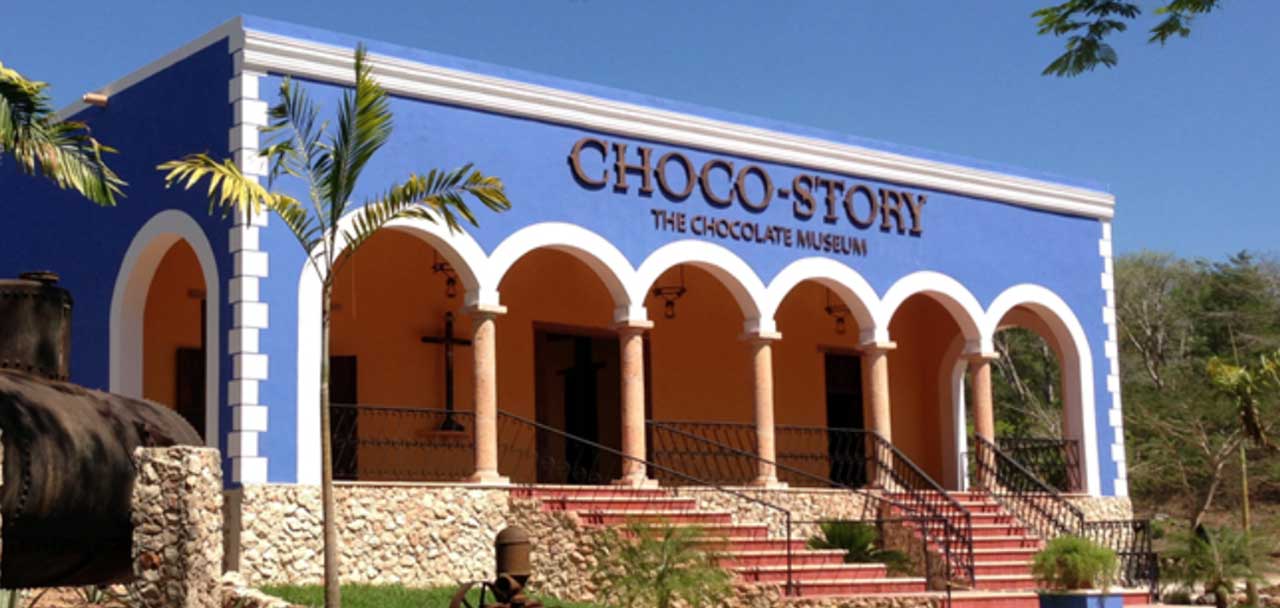
If you’re visiting Uxmal Mayan ruins why not add something different to your trip? The Uxmal Chocolate Museum, properly known as Choco-Story Uxmal, is across the road from the entrance to the archaeological site. (There are other Choco-Story locations around the Yucatan).
Designed to give visitors an idea of Mayan culture and the sacredness of cacao, the museum is next to a 300-hectare (741 acres) cacao plantation.
You’ll learn how cacao, the bean from which chocolate is made.
The plantation grows cacao beans. Cocoa is the product from the cacao beans used to make the chocolate. Various displays explain this and the process involved, along with modern and ancient equipment used in the process. And, of course, you enjoy samples!
The process and other displays are in different Mayan huts. As you wander between them you have the chance to wander through a section of ‘jungle’.
There is also a small zoo with rescued animals.
The tour will probably take between 1 and 2 hours depending on how long you spend in each area. The cost is MXN180 per person.
The Mayan Planetarium
Right next to the Uxmal Chocolate Museum is the Uxmal Mayan Planetarium.
The Mayan Planetarium offers a 25-minute visual presentation about Mayan history, with a virtual tour of some of the more famous Mayan cities. This also shows how the Mayans incorporated astronomy into their building designs. Like the Chocolate Museum, entry is MXN180.
Cenotes near Uxmal
Cenote Kankirixche
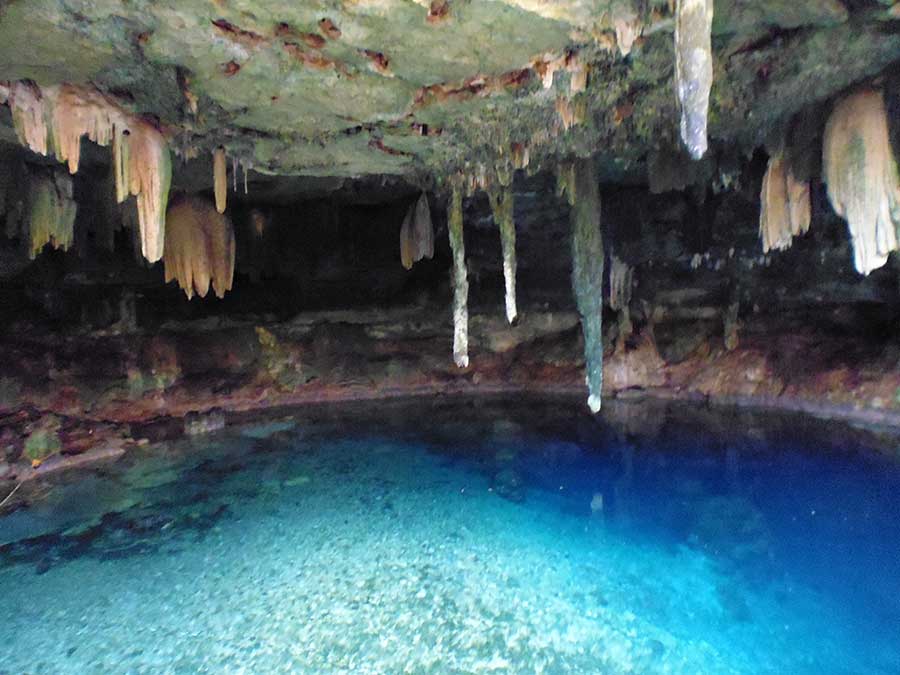
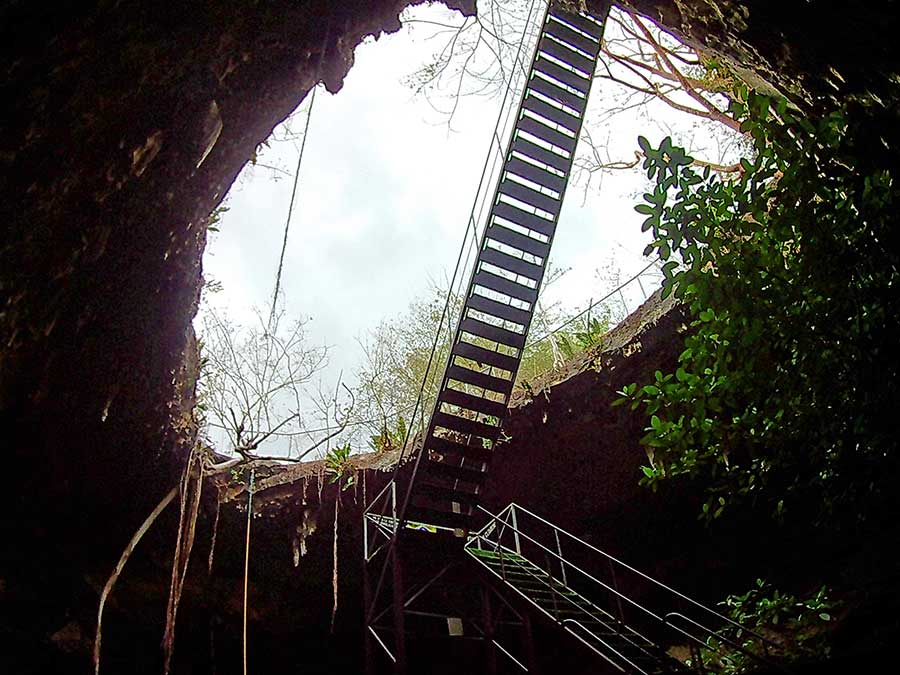
There are no nice cenotes in the immediate area of Uxmal. But on the way back from Uxmal to Merida, you pass within 20 minutes of one of our favorite Yucatan cenotes – Cenote Kankirixche. It’s a detour well-worth making.
Just follow the same road from Uxmal to Merida you came on the 261 for about 30 minutes. When you come to turning to the small town of Abala, turn right. Go through Abala and continue for about 10 minutes. You’ll see a signposted turning to Cenote Kankirixche on you left. From there it’s a dirt road for about a mile until you reach the cenote.
The cenote is semi-underground and reached by climbing down a set of wooden steps. You are surrounded by the walls of the cavern but with the sky open above you, providing an amazing atmosphere.
At the back of the cavern are some large stalactites hanging just above the water.
You can snorkel and look for the fish or just swim in this amazing cenote. It’s a great way to complete a day at Uxmal!
Click here for more information about Cenote Kankirixche and other cenotes.
Do you want to learn about other fascinating Mayan ruins? Click Best Mayan Ruins in the Yucatan Peninsula
David H
After spending months in places like Playa del Carmen and Ajijic (near Lake Chapala, Guadalajara), my family and I have been living for the past four years in the Yucatan and enjoying this fabulous part of Mexico.
I've written many travel blogs for other travel sites over the years before starting Wonky Compass. I have three books published on Amazon.
Copyright 2024 www.wonkycompass.com